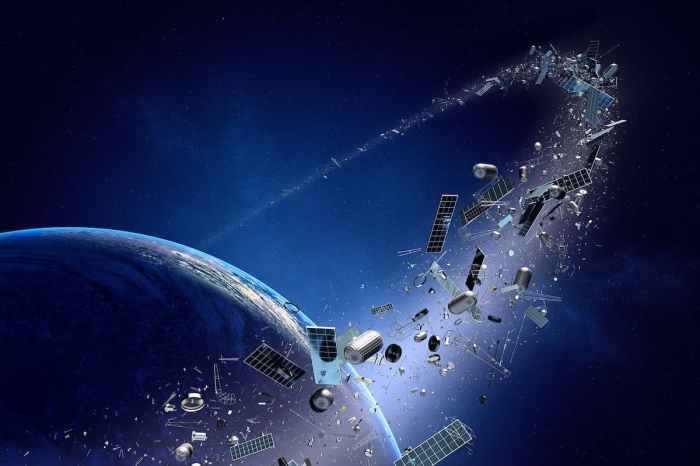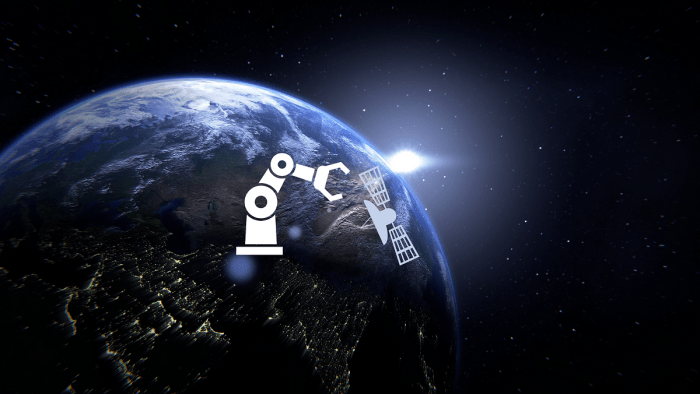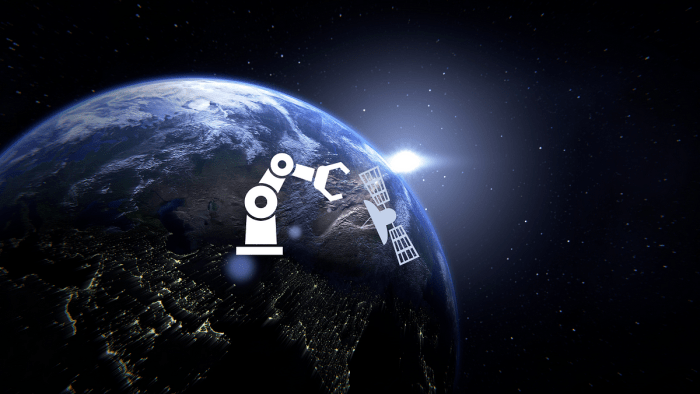SpaceTech Startups Propose Space Debris Avoidance Solutions – The vast expanse of space, once a symbol of boundless possibility, is now facing a growing threat: space debris. This invisible hazard, consisting of discarded satellites, rocket parts, and other remnants of human exploration, poses a serious risk to operational satellites and future space missions.
As the amount of space debris continues to accumulate, spacetech startups are stepping up to tackle this challenge, developing innovative technologies and approaches to prevent collisions and safeguard the future of space exploration.
The problem of space debris is not a new one, but it has become increasingly urgent in recent years. The rapid growth of the space economy, with more satellites being launched than ever before, has contributed to a significant increase in the amount of debris in orbit.
This debris can travel at incredibly high speeds, making collisions potentially catastrophic. Not only can collisions damage or destroy valuable satellites, but they can also create even more debris, exacerbating the problem. The potential consequences of uncontrolled space debris are far-reaching, threatening the future of space exploration and jeopardizing the vital services that satellites provide to our planet.
The Growing Problem of Space Debris
The Earth’s orbit is increasingly becoming cluttered with space debris, posing a significant threat to operational satellites and future space missions. This debris, ranging from spent rocket stages to fragments from collisions, can cause catastrophic damage to spacecraft, jeopardizing critical infrastructure and scientific endeavors.
The Current State of Space Debris
The amount of space debris in orbit is a pressing concern. According to the European Space Agency (ESA), there are over 130 million pieces of debris larger than 1 centimeter in diameter, and millions more smaller fragments. The United States Space Force’s Space Surveillance Network (SSN) tracks over 27,000 objects larger than 10 centimeters.
This debris poses a significant risk to operational satellites and future space missions.
The Consequences of Space Debris
The consequences of space debris collisions can be devastating. In 2009, a defunct Russian satellite collided with a functioning Iridium communications satellite, creating thousands of new debris fragments. This event highlights the potential for cascading collisions, known as the Kessler Syndrome, which could render near-Earth orbit unusable for future space exploration and satellite operations.
The Risks Posed by Space Debris
Space debris poses numerous risks to operational satellites and future space missions:
- Collisions: Debris can collide with operational satellites, causing damage or destruction. The International Space Station (ISS) has had to maneuver several times to avoid collisions with debris.
- Functional Degradation: Debris can damage satellite components, such as solar panels or antennas, leading to reduced performance or even failure.
- Increased Risk of Future Collisions: The presence of debris increases the likelihood of future collisions, creating a cascading effect that can further exacerbate the problem.
- Limited Access to Space: The increasing amount of debris can make it difficult and dangerous to launch new satellites and conduct space missions.
SpaceTech Startups Leading the Charge: Spacetech Startups Propose Space Debris Avoidance

The growing concern over space debris has spurred the emergence of innovative spacetech startups dedicated to tackling this challenge. These startups are developing cutting-edge technologies and approaches to prevent further debris accumulation and mitigate existing threats.
Strategies for Space Debris Avoidance
Spacetech startups are employing diverse strategies to address the space debris problem. Their solutions encompass various aspects, from active debris removal to spacecraft design and mission planning.
Active Debris Removal
Active debris removal involves physically capturing or removing debris from orbit. This approach is particularly effective for large, defunct satellites or rocket stages.
- Astroscale: A Japanese startup, Astroscale, has developed a unique debris removal system called “End-of-Life Services” (ELSA). ELSA consists of two spacecraft: a “chaser” that captures and removes debris and a “servicer” that provides support and navigation. Astroscale aims to demonstrate the effectiveness of ELSA through a series of missions, starting with the removal of a defunct Japanese satellite.
- ClearSpace: Based in Switzerland, ClearSpace is focusing on removing large pieces of debris from low Earth orbit (LEO). Their first mission, ClearSpace-1, aims to capture and remove a Vespa rocket upper stage, weighing approximately 100 kg, from orbit. This mission will demonstrate the feasibility and effectiveness of their debris removal technology.
Spacecraft Design and Mission Planning
Designing spacecraft with features that minimize debris generation and incorporating debris avoidance into mission planning are crucial for preventing future debris accumulation.
- Swarm Technologies: This American startup is developing a constellation of small satellites for providing internet connectivity. They have designed their satellites to be “debris-free” by incorporating features that minimize the risk of generating debris during their operational lifespan and at the end of their mission.
This includes using non-explosive mechanisms for deorbiting and ensuring the satellites are designed to break up into smaller, less hazardous pieces upon re-entry into the atmosphere.
- Spire Global: Another American startup, Spire Global, is focusing on building a large constellation of nanosatellites for Earth observation and data analytics. Their approach to debris avoidance includes careful mission planning, minimizing the use of consumables, and ensuring their satellites are designed to deorbit safely at the end of their mission.
Spire Global aims to minimize the risk of creating new debris while maximizing the benefits of their satellite constellation.
Collision Avoidance Systems
Developing advanced collision avoidance systems for spacecraft is essential for mitigating the risk of collisions with existing debris. These systems rely on sophisticated algorithms and sensors to detect potential collisions and maneuver spacecraft accordingly.
- LeoLabs: An American startup, LeoLabs, has developed a ground-based radar network that provides real-time tracking and collision avoidance services for spacecraft in LEO. Their radar system can detect and track objects as small as 10 cm, providing valuable data for spacecraft operators to make informed decisions about collision avoidance maneuvers.
- Space Domain Awareness (SDA): The US Space Force’s SDA program is investing in developing advanced space situational awareness (SSA) capabilities, including the use of ground-based and space-based sensors to track and monitor space objects. The data collected by SDA will be used to improve collision avoidance systems and enhance the safety of space operations.
Technologies for Space Debris Mitigation

Space debris mitigation is crucial for the long-term sustainability of space activities. Various technologies are being developed and implemented to address this growing problem. These technologies can be broadly categorized into active debris removal, passive debris mitigation, and operational procedures.
Active Debris Removal Technologies
Active debris removal involves directly interacting with debris objects to remove them from orbit.
- Spacecraft Capture and Removal: This technology involves using a spacecraft to capture and remove debris from orbit. The debris can be captured using a net, harpoon, or robotic arm, and then deorbited or moved to a graveyard orbit. This approach is effective for larger debris objects.
- Debris Disintegration: This method involves using lasers or other high-energy sources to disintegrate debris objects into smaller pieces. These smaller pieces would then be more likely to burn up in the atmosphere. This technology is still in its early stages of development, but it has the potential to be very effective for removing larger debris objects.
- Debris Deflection: This approach involves using a spacecraft to deflect debris objects away from critical orbits or assets. This can be achieved by using a laser, a mass driver, or a robotic arm to nudge the debris object. This technology is particularly useful for preventing collisions with active satellites or space stations.
Passive Debris Mitigation Technologies
Passive debris mitigation involves designing spacecraft and components to minimize the creation of debris in the first place.
- Design for Demise: This involves designing spacecraft to break up into smaller pieces upon re-entry into the atmosphere, ensuring they burn up completely. This reduces the risk of large debris fragments surviving re-entry and becoming space debris.
- Self-Destruct Mechanisms: These mechanisms allow spacecraft to be deliberately destroyed at the end of their mission, preventing them from becoming uncontrolled debris. This is particularly important for spacecraft in critical orbits.
- Collision Avoidance Systems: These systems are designed to detect and avoid collisions with other objects in space, including debris. This helps to prevent the creation of new debris through collisions.
Operational Procedures for Debris Mitigation, Spacetech startups propose space debris avoidance
Operational procedures play a vital role in reducing the risk of debris generation.
Find out further about the benefits of why python continues to reign supreme on the job market that can provide significant benefits.
- Stricter Launch and Operation Regulations: Governments and space agencies are implementing stricter regulations for the launch and operation of spacecraft to minimize debris generation. These regulations include requirements for debris mitigation measures, such as collision avoidance procedures and end-of-life disposal plans.
- Space Traffic Management: This involves coordinating the movement of spacecraft in orbit to minimize the risk of collisions. This includes sharing data on spacecraft trajectories and debris locations to facilitate collision avoidance maneuvers.
- Debris Tracking and Monitoring: Continuous monitoring of the space environment is essential for identifying and tracking debris objects. This data is used to assess the risk of collisions and to develop strategies for debris mitigation.
Policy and Regulation for Space Debris Management
The burgeoning space economy, with its increasing reliance on satellites for various applications, necessitates a robust regulatory framework for space debris management. International regulations and policies aim to mitigate the growing threat of space debris and ensure the long-term sustainability of space activities.
Existing International Regulations and Policies
The international community has established a set of regulations and policies to address the space debris issue. The most prominent among these is the United Nations (UN) Committee on the Peaceful Uses of Outer Space (COPUOS), which has developed a series of Space Debris Mitigation Guidelines. These guidelines, adopted in 2007 and updated in 2010, provide a comprehensive set of recommendations for spacecraft design, launch operations, and post-mission disposal.
- Spacecraft Design:The guidelines recommend incorporating features into spacecraft design that minimize the creation of debris during launch and in-orbit operations. This includes using materials that fragment less readily upon impact, designing for controlled re-entry, and incorporating collision avoidance systems.
- Launch Operations:The guidelines encourage the use of launch procedures that minimize the risk of debris generation. This includes ensuring proper separation of launch vehicle stages, avoiding the intentional release of debris, and implementing contingency plans for launch failures.
- Post-Mission Disposal:The guidelines recommend disposing of spacecraft at the end of their mission in a way that minimizes the risk of creating debris. This includes deorbiting spacecraft to re-enter the atmosphere and burn up, or placing them in a graveyard orbit where they pose minimal risk to other spacecraft.
Challenges in Implementing and Enforcing Regulations
While these regulations provide a solid framework, their implementation and enforcement face several challenges:
- Lack of Universal Enforcement Mechanisms:There is no international body with the authority to enforce the guidelines. Compliance relies on individual countries’ national regulations and voluntary adherence by spacefaring nations.
- Technological Limitations:Current technologies for space debris removal are still under development, and their cost and effectiveness remain a challenge. The lack of readily available solutions makes it difficult to enforce regulations that require the removal of debris.
- Lack of Consensus on Responsibility:There is no clear consensus on the responsibility for managing space debris, especially for legacy debris created before the guidelines were established. This ambiguity makes it difficult to allocate responsibility for cleanup efforts.
Potential Improvements or New Regulations
To address these challenges, several potential improvements or new regulations can be considered:
- Strengthening International Cooperation:Enhancing collaboration among spacefaring nations through the UN COPUOS and other international organizations is crucial for effective space debris management. This includes sharing data, developing joint standards, and coordinating cleanup efforts.
- Developing International Liability Mechanisms:Establishing clear liability mechanisms for space debris damage could incentivize responsible space activities and encourage cooperation in debris removal. This could involve a system of financial compensation for damages caused by space debris, similar to the International Maritime Organization’s liability regime for maritime accidents.
- Promoting Technological Advancements:Increased investment in research and development of space debris removal technologies is essential. This includes developing innovative methods for capturing, deorbiting, and disposing of debris, as well as improving collision avoidance systems.
- Establishing a Space Traffic Management System:Implementing a global space traffic management system could help to prevent collisions and mitigate the risk of debris generation. This system could monitor spacecraft orbits, provide collision warnings, and facilitate coordination among space operators.
The Future of Space Debris Avoidance
The future of space debris avoidance is bright, driven by the relentless innovation of spacetech startups. These startups are not only tackling the current debris problem but also shaping the future of space exploration by developing cutting-edge technologies and advocating for responsible space practices.
The Role of Spacetech Startups
Spacetech startups are at the forefront of developing and implementing innovative solutions to address the growing space debris problem. They bring a fresh perspective and agility to the field, often developing more cost-effective and efficient technologies compared to traditional space agencies.
- Developing Advanced Tracking and Monitoring Systems:Startups are developing advanced sensors and algorithms to track debris with greater precision and accuracy. This enables more accurate predictions of potential collisions, allowing for timely avoidance maneuvers.
- Creating Innovative Debris Removal Technologies:Startups are actively developing technologies to actively remove debris from orbit. These include laser-based systems, robotic arms, and even nets to capture and deorbit debris.
- Promoting Responsible Space Practices:Startups are advocating for the adoption of responsible space practices, such as designing spacecraft for easier deorbiting and implementing stricter guidelines for debris mitigation.
Potential Breakthroughs and Innovations
The future of space debris avoidance holds immense potential for groundbreaking innovations.
- Autonomous Debris Removal:The development of fully autonomous robots capable of identifying, capturing, and deorbiting debris without human intervention could significantly accelerate debris mitigation efforts. Imagine a swarm of robotic spacecraft autonomously cleaning up space, removing debris from high-risk orbits.
- Space Debris Recycling:Startups are exploring the potential of recycling space debris into useful materials. This could be a game-changer, transforming debris from a problem into a resource.
- Advanced Propulsion Systems:The development of more efficient and powerful propulsion systems could enable faster and more precise debris removal operations. This could involve technologies like ion propulsion or laser-based propulsion.
A Future with Effective Debris Mitigation
Imagine a future where space debris is effectively mitigated, enabling sustainable and safe space exploration.
- A Network of Debris Removal Satellites:A constellation of specialized satellites equipped with advanced debris removal technologies could continuously monitor and clean up space, preventing the accumulation of debris in critical orbits.
- Space Traffic Management Systems:Sophisticated space traffic management systems could coordinate the movement of spacecraft, avoiding collisions and minimizing the risk of generating new debris.
- International Cooperation:Strong international cooperation on space debris mitigation would be essential for a successful future. This could involve sharing data, developing common standards, and collaborating on debris removal projects.





